|
|
|
Sort Order |
|
|
|
Items / Page
|
|
|
|
|
|
|
| Srl | Item |
| 1 |
ID:
177119


|
|
|
|
|
| Summary/Abstract |
Considerable efforts have been made to increase the energy efficiency of school buildings across the country. Despite this, limited research examines the relationship between energy efficiency and student productivity. We use a unique panel dataset from a suburban school district that includes information on school building energy efficiency, measured by Energy Star scores, and other environmental attributes of buildings, as well as measures of individual student achievement, measured by standardized test scores. The empirical analysis controls for student and school fixed effects and evaluates the relationship between school characteristics and achievement. Separate models also evaluate how school characteristics impact student health and behavioral outcomes and the how these outcomes influence student test scores. We find no evidence that Energy Star scores have an impact on the indoor school environment or student performance on standardized tests, suggesting that building energy performance does not come at a cost to the performance of building inhabitants. We also find positive relationships between building thermal comfort and visual quality and standard test scores. Overall, the results highlight the importance of considering both the environmental and human capital impacts associated with decisions about investments in school infrastructure.
|
|
|
|
|
|
|
|
|
|
|
|
|
|
|
|
| 2 |
ID:
177143
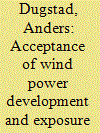

|
|
|
|
|
| Summary/Abstract |
Despite a large stated-preference (SP) literature on wind power externalities, few SP studies employ a case-control approach to examine whether people's acceptance of new wind power developments and renewable energy initiatives increases or decreases with exposure. Furthermore, the existing studies are inconclusive on this issue. In a case-control discrete choice experiment, we measure the level of acceptance in terms of people's willingness-to-accept (WTA) for having future land-based wind power developments in Norway; comparing exposed and non-exposed people's WTA. We find that exposure lowers acceptance. Furthermore, exposed people are also unwilling to pay as much to increase general domestic renewable energy production (from all sources) as non-exposed people, and thus have lower acceptance for such renewable energy policy initiatives. After testing for type of exposure, we argue that the inconclusiveness in the literature of how exposure affects acceptance of wind power developments could be due to the fact that impacts considered differ somewhat across studies.
|
|
|
|
|
|
|
|
|
|
|
|
|
|
|
|
| 3 |
ID:
177110


|
|
|
|
|
| Summary/Abstract |
This paper explores the trends, step changes and innovations that could impact the integration of renewable energy into electricity systems, explores interventions that may be required, and identifies key areas for policy makers to consider. A Delphi approach is used to collect, synthesise, and seek consensus across expert viewpoints. Over sixty experts across a range of geographies including the US, Europe, New-Zealand, Australia, Africa, India and China participated. They identified 26 trends, 20 step changes, and 26 innovations that could lead to major shifts in the design, operation, or management of electricity systems. Findings suggest that key challenges are not technological. Instead they are with delivering an aligned vision, supported by institutional structures, to incentivise, facilitate, and de-risk the delivery of a completely different type of energy system. There is a clear role for government and policy to provide a future energy vision and steer on strategic issues to deliver it; to create space for new actors and business models aligned with this vision; and to create an environment where research, development, demonstration and deployment can promote technologies, system integration and business model innovation at a rate commensurate with delivering net-zero electricity systems.
|
|
|
|
|
|
|
|
|
|
|
|
|
|
|
|
| 4 |
ID:
177113


|
|
|
|
|
| Summary/Abstract |
Although numerous studies have examined the economic benefits of demand response programs, the environmental impacts of such programs have been relatively underexplored. This study assesses the impact of demand resource bidding on the wholesale energy market and the environment, based on three years of high temporal-resolution data from Korea. In this demand resource bidding program, successful bidders were paid the system marginal price for reducing their electrical load at a given hour, which in turn reduced the generation of power from various technologies. This investigation of how carbon dioxide and particulate matter emissions from existing power systems changed with the introduction of the demand bidding program finds that the program altered the system operator's electricity generation portfolio and marginally abated carbon dioxide and particulate matter emissions from the power sector. It also shows that the environmental impact of the program varied over the course of the day and the year. The modest but statistically significant environmental impact of the demand resource bidding program points to the importance of including electricity demand resources in the discussion and development of energy and environmental policies for the power sector.
|
|
|
|
|
|
|
|
|
|
|
|
|
|
|
|
| 5 |
ID:
177140


|
|
|
|
|
| Summary/Abstract |
As coalbed methane, the natural gas adsorbed in coal seams, is a greenhouse gas that is 21 times stronger than CO2, coalbed methane extraction significantly influences carbon reduction and energy conservation efforts. While the injection of CO2 into coal seams is known to effectively enhance coalbed methane recovery, this process has been limited because of high investment and production costs. Therefore, to promote the application of CO2 injection techniques in coalbed methane industry, this paper proposes an authority–enterprise equilibrium based mixed subsidy mechanism which combines direct subsidies with indirect tax-incentives. Specifically, a multi-objective bi-level programming model is established under uncertainty to assign a practical constraint and achieve a trade-off between the local authority and the coalbed methane plants. A practical case validates the feasibility and efficiency of the proposed method, proving that an authority–enterprise equilibrium based mixed subsidy mechanism is able to achieve carbon emissions reductions and conserve energy. Further analysis indicated that the marginal energy efficiency gains were greater than the authority costs under a strict energy utilization policy and that the environmental protection target had larger impacts on the coalbed methane plant performances.
|
|
|
|
|
|
|
|
|
|
|
|
|
|
|
|
| 6 |
ID:
177154


|
|
|
|
|
| Summary/Abstract |
This study evaluated the effectiveness of technology-push and market-pull policies in encouraging the production and use of biofuels in 15 countries including major biofuels producers. Biofuels production and consumption data for the 12-year period of 2006-2017 showed that in most of the surveyed countries, biofuels policies played an important role in developing and growing regional and national biofuels markets. Blending mandates continue to be the main market-pull policy used to create and expand biofuels markets. Countries with a mixture of market-pull and technology-push policy instruments have been most successful at increasing biofuels production and use and also developing and deploying less mature advanced biofuels. Most policies have primarily promoted the production and use of biofuels for road transport with key long-distance transport sectors (aviation and shipping) drawing less policy attention despite being significant fuel consumers and carbon emitters. While many older policies were originally developed to promote energy security, more recent policies, such as low carbon fuel standard, have reduction in the carbon intensity of transportation fuels as a primary goal. While policies have been essential in promoting the on-going growth of biofuels, they have not been sufficient to drive the level of development needed to decarbonize the transport sector.
|
|
|
|
|
|
|
|
|
|
|
|
|
|
|
|
| 7 |
ID:
177151
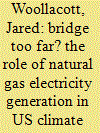

|
|
|
|
|
| Summary/Abstract |
Natural gas has been promoted as a ‘‘bridge’’ fuel toward a low-carbon future by offering near-term emissions reductions at lower cost. Existing literature is inconclusive on the short-term emissions benefits of more abundant natural gas. The long-lived nature of natural gas infrastructure also threatens to lock in emissions levels well above longer-term targets. If natural gas can offer short-to-medium term benefits, how much of a bridge should we build? Using ARTIMAS, a foresighted computable general equilibrium model of the US economy, we interact scenarios developed by the EMF-34 study group related to abundant natural gas, low-cost renewables, and a carbon tax to examine the role of natural gas in a carbon-constrained future. We find that abundant natural gas alone does not have a significant impact on CO2 emissions. We also find that, under a higher carbon tax, natural gas investment of approximately $10 billion per year declines to zero at a tax of about $40/ton and existing natural gas assets face significant risk of impairment. Last, the presence of abundant natural gas lowers the marginal welfare cost of abating small amounts of CO2 but is likely to raise the cost of abatement levels consistent with common climate objectives. The integrated welfare costs of climate policy depend on how much abatement we must undertake.
|
|
|
|
|
|
|
|
|
|
|
|
|
|
|
|
| 8 |
ID:
177153
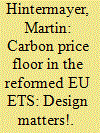

|
|
|
|
|
| Summary/Abstract |
Despite the reform of the European Emissions Trading System (EU ETS), discussions about complementing it with a carbon price floor (CPF) are ongoing. This paper analyzes the effect of a European CPF in the reformed EU ETS using a Hotelling model of the EU ETS, amended by the market stability reserve (MSR), and the cancellation mechanism. Two CPF designs are compared: (1) a buyback program and (2) a top-up tax. The buyback program sets a minimum price for the allowances from the implementation year onwards. After the announcement, firms anticipate the CPF, which immediately increases the carbon price to the discounted CPF level. Therefore, firms emit less and bank more allowances, leading to more intake into the MSR, and more cancellation of allowances. The top-up tax imposes a tax on emissions, which enhances the market price of allowances to the CPF level from the implementation year onwards. Firms increase their short-run emissions in anticipation of the upcoming tax. Only after the implementation year firms start to lower their emissions. Thus, the effect on aggregate cancellation is ambiguous. Despite being equivalent in a static setting, the design choice for the CPF matters in a dynamic context, such as the EU ETS.
|
|
|
|
|
|
|
|
|
|
|
|
|
|
|
|
| 9 |
ID:
177162
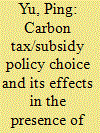

|
|
|
|
|
| Summary/Abstract |
Interest groups, such as industry organization, public finance and environmental group, may exert influences on policy makers when they are choosing environmental policies. Considering the situation that two countries, where a domestic country suffers equal influence and a foreign country suffers different influences from these groups, can choose carbon tax policy or carbon subsidy policy. Then this paper constructs a two-staged game model to study how interest groups make differences to environmental policy choices, and their impacts on policy level, production (carbon emission), profit and welfare between countries. Results show that the domestic country will definitely choose carbon tax policy, but the foreign country may make different choices. Furthermore, if the foreign country chooses carbon subsidy policy, the domestic country will set higher tax rate than the foreign country does, but production (carbon emission), profit and welfare of the domestic country will be lower than those of the foreign country. If the foreign country chooses carbon tax policy, carbon tax rate, production (carbon emission), profit and welfare are ambiguous between countries.
|
|
|
|
|
|
|
|
|
|
|
|
|
|
|
|
| 10 |
ID:
177169


|
|
|
|
|
| Summary/Abstract |
The research paper examines Central Asia Regional Economic Cooperation (CAREC) integrated energy market potentials, challenges, and opportunities for 1) harnessing untapped renewable energy potential; 2) promoting the cross-border trade to cater the rising regional demand mismatch of electricity; 3) improving energy security; and 4) reducing the carbon footprint of the region. The research demonstrates that the CAREC Energy Corridor (CEC) will optimize regional trade cooperation by building cross-border energy trade infrastructure, systems, and governance mechanisms by employing a Regional Public Goods (RPG) framework. The research finds that a one percent increase in energy imports within the region is associated with the reduction in carbon dioxide emissions by 0.245 kg per $ of GDP; the increase in the Gross Domestic Product (GDP) per unit of energy use by 0.233 per kg of oil equivalent; and the growth in electricity production from renewable sources by 0.414 kW hour, thus improving regional electricity affordability, access, and energy security. The cost benefit analysis reveals that traditional (fossil fuel or hydro) power generation and transmission costs must either beat or match the price competition and transmission flexibility options offered by renewables to sustain competitiveness of the regional electricity market.
|
|
|
|
|
|
|
|
|
|
|
|
|
|
|
|
| 11 |
ID:
177165
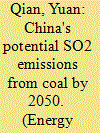

|
|
|
|
|
| Summary/Abstract |
Coal is the dominant emitter of Sulfur Dioxide (SO2) in some countries, comprising ~92% of total emissions in China. Mitigation of these emissions can be driven by a number of factors, such as energy-efficiency improvements, installation of scrubbers, and use of renewable energy. This study evaluates the historical reduction of overall SO2 emission intensity from coal consumption for 30 Chinese provinces between 2000 and 2016. These trends are further combined with expected coal use from 2020 to 2050 along with scenarios of future power generation to explore China's future SO2 emissions. The results show that provinces starting with a high emission intensity in general have higher reduction rates. By 2050, China's potential SO2 emissions are between 3.9 Mt and 4.1 Mt, and industry mitigation efforts, such as the installation of scrubbers, appear to contribute most to abatement. Additionally, this study estimates the impact on global average temperatures from SO2 mitigation due to the adoption of renewables in the electric sector using the MAGICC model and find an increase of ~0.01 °C by 2050. Considering the reduced abatement opportunities of desulfurization technologies and climate change effects of coal combustion, renewable energy provides the most promising option for SO2 mitigation.
|
|
|
|
|
|
|
|
|
|
|
|
|
|
|
|
| 12 |
ID:
177124
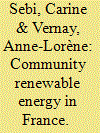

|
|
|
|
|
| Summary/Abstract |
Citizens can take an active part in the energy transition by participating in community renewable energy projects (CREPs). CREPs are emerging in France but their growth is simultaneously rapid and fragile. This paper describes the ongoing CRE movement in France based on an in-depth analysis at both the national and regional levels. To embrace the diversity of initiatives that exist, the paper proposes a typology of CREPs based on governance type and project size. We discuss the institutional, market, organisational and behavioural barriers that CREPs face. We also posit three enabling factors—financial, network and local capacity builders—and show that these factors contribute to explaining observed geographical disparities. We argue that policymakers should recognize the plural role that CREPs can play locally and develop support schemes that reflect this plurality instead of pushing for ever-bigger projects. Finally, because CREPs are not able to meet the growing demand for locally sourced renewable energy, we posit that regulations should evolve to offer CREP participants the opportunity to consume CRE-generated energy and to directly link that consumption to their own energy bills.
|
|
|
|
|
|
|
|
|
|
|
|
|
|
|
|
| 13 |
ID:
177118


|
|
|
|
|
| Summary/Abstract |
The study proposes an approach to assess a hidden aspect of energy poverty (EP) in Poland. We consider households' energy under-consumption driven by low energy efficiency and budgetary constraints. A household is exposed to hidden energy poverty (HEP) if it's total disposable income after deducting the expected housing cost falls under the established threshold. To approximate the expected total housing expenditures, the data from the EU-SILC dataset on dwellings parameters, households' attributes and regional characteristics of Poland is used.
|
|
|
|
|
|
|
|
|
|
|
|
|
|
|
|
| 14 |
ID:
177167


|
|
|
| 15 |
ID:
177131


|
|
|
|
|
| Summary/Abstract |
The ambitious carbon-reduction targets set out by the Paris Agreement, or by recent Green Deals such as the one launched by European Commission President Ursula von der Leyen, will require a high degree of engagement with the public. This is true not only as important changes in lifestyle are going to be needed from citizens, especially in developed economies, but also because top-down measures will need public approval to be put in place. This paper reviews literature from behavioural and environmental economics, cognitive sciences, (social) psychology, health policy, and marketing to condense key insights on how to make communication on the green transition more effective in terms of citizens’ engagement. In doing so, it distils six policy recommendations that can serve as building blocks for an impactful narrative accompanying decarbonisation strategies, in Europe and beyond. If used skilfully, an effective communication and consequent behavioural change holds the promise of complementing top-down financial and regulatory tools, accelerating the green transition.
|
|
|
|
|
|
|
|
|
|
|
|
|
|
|
|
| 16 |
ID:
177155


|
|
|
|
|
| Summary/Abstract |
The United States (US), the largest economy in the world, emits more carbon dioxide (CO2) emissions each year than any country except China. Therefore, to mitigate the country's CO2 emissions effectively, it is essential to identify the driving forces of its emission changes. Using an extended logarithmic mean Divisia index (LMDI) method, this study decomposes US aggregate and sectoral emissions changes between 1997 and 2016 into six factors. Also, to seek for the possible mitigation pathways of the US emissions over the period 2020–2030, a scenario analysis is employed. The results indicate that: (1) For the growth of US emissions over 1997–2016, the main influencing factor is the scale effect (income and population), while the technology effect (energy intensity and emission coefficient) is the key driving force in mitigating US emissions; (2) although the structure effect (economic structure and energy consumption structure) also has a mitigating effect on US emissions, it plays a comparatively minor role; and (3) the forecast results suggest that the 2020 target released by the United Nations Framework Convention on Climate Change (UNFCCC) can be achieved under the moderate and advanced scenarios, while the 2025 target cannot be achieved under the three scenarios.
|
|
|
|
|
|
|
|
|
|
|
|
|
|
|
|
| 17 |
ID:
177171
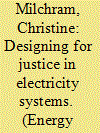

|
|
|
|
|
| Summary/Abstract |
In future urban energy systems, smart grid systems will be crucial for the integration of renewable energy. However, their deployment has moral implications, for example regarding data privacy, user autonomy, or distribution of responsibilities. ‘Energy justice’ is one of the most comprehensive frameworks to address these implications, but remains limited regarding smart grids, and regarding concrete guidelines for designers and policymakers. In this paper, we fill this gap by answering the following research question: How do design choices in smart grid projects impact energy justice? Thereby, four smart grid pilot projects are evaluated in a comparative qualitative case study research design. Data was collected through semi-structured interviews and a content analysis. Our findings contribute to the energy justice literature with insights regarding the design for distributive, recognition, and procedural justice. They underscore the importance of fairness in data governance, participatory design, user control and autonomy, technology inclusiveness, and the design for expansion and replication. Future research should explore the feasibility to govern smart grids as commons and the relationship between trust and perceptions of justice. We conclude with policy recommendations for funding future smart grid experiments and for facilitating the implementation of storage through electricity sector regulation.
|
|
|
|
|
|
|
|
|
|
|
|
|
|
|
|
| 18 |
ID:
177138
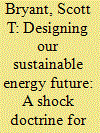

|
|
|
|
|
| Summary/Abstract |
A lack of understanding amongst industry and government regarding future business model and policy routes for achieving renewable energy targets risks society falling short of the energy transition required to help limit global heating to 1.5 °C. Despite a lack of clarity regarding the business- and governance-models required to facilitate such a transition, the urgency for achieving this shift is becoming increasingly apparent amongst industry and government. This paper explores the business and governance-models seen as likely to facilitate the adoption and uptake of sufficient levels of VRE to meet the global energy sector's climate crisis mitigation responsibilities. A Grounded Theory approach was undertaken to investigate and analyse the results of 28 semi-structured interviews, the coding of which involved the identification of 4 themes and 12 sub-themes. These themes allowed the development of an overarching sectoral pathway solution, framed in the form of a ‘government keystone model’, that exemplifies the current sectoral reality that governments hold the power to clearly design and implement an economically, environmentally and societally beneficial shift to high levels of VRE. It is argued this proactive role could be adopted using the looming “shock” to the margins of traditional energy business models by rising levels of VRE.
|
|
|
|
|
|
|
|
|
|
|
|
|
|
|
|
| 19 |
ID:
177097


|
|
|
|
|
| Summary/Abstract |
This paper investigates the determinants of smart energy tracking app usage by citizens residing in French cities. Our framework is inspired by the extant strands of literature on smart cities and smart home technology adoption, but also contributing to them as smart energy applications reveal specificities that need to be incorporated; the latter include, for instance, the distinction between adoption and frequency of use, or the consideration of additional determinants such as privacy or environmental concerns. For our study, we build an original survey and rely upon citizen-level data, testing a Zero-Inflated Ordered Probit (ZIOP) model which allows to differentiate between adoption of the smart energy app and its frequency of utilization. Our empirical findings reveal how the drivers related to smart city characteristics mainly affect the decision of adoption of energy tracking apps. Conversely, the more individual characteristics related to the perceived benefits of using energy tracking apps, dwelling type, and privacy concerns, primarily affect the frequency of utilization. Our results bear policy implications on the issue of privacy, premising additional research on energy challenges in the utilization of energy apps in smart versus non-smart environments.
|
|
|
|
|
|
|
|
|
|
|
|
|
|
|
|
| 20 |
ID:
177111


|
|
|
|
|
| Summary/Abstract |
Competitive electricity markets can procure reserve generation through a market in which the demand for reserves is administratively established. A downward sloping or stepped administrative demand curve is commonly termed an operating reserve demand curve (ORDC). We propose a dynamic formulation of an ORDC with generator forced outage probabilities conditional on ambient temperature to implement scarcity pricing in a wholesale electricity market. This formulation improves on common existing methods used by wholesale market operators to articulate ORDCs by explicitly accounting for a large source of observed variability in generator forced outages, whereby for a fixed load, more reserves are required during times of extreme heat and cold to maintain a constant risk of reserve shortage. Such a dynamic ORDC increases social welfare by $17.1 million compared to current practice in the PJM Interconnection during a high load week in a welfare-maximizing electricity market with co-optimized procurement of energy and reserves. A dynamic ORDC increases reserve prices under scarcity conditions, but has minimal effects on total market payments. The results are directly relevant to the modeled two-settlement electricity market in PJM, which is currently undergoing enhancements to its ORDC.
|
|
|
|
|
|
|
|
|
|
|
|
|
|
|
|
|
|
|
|
|